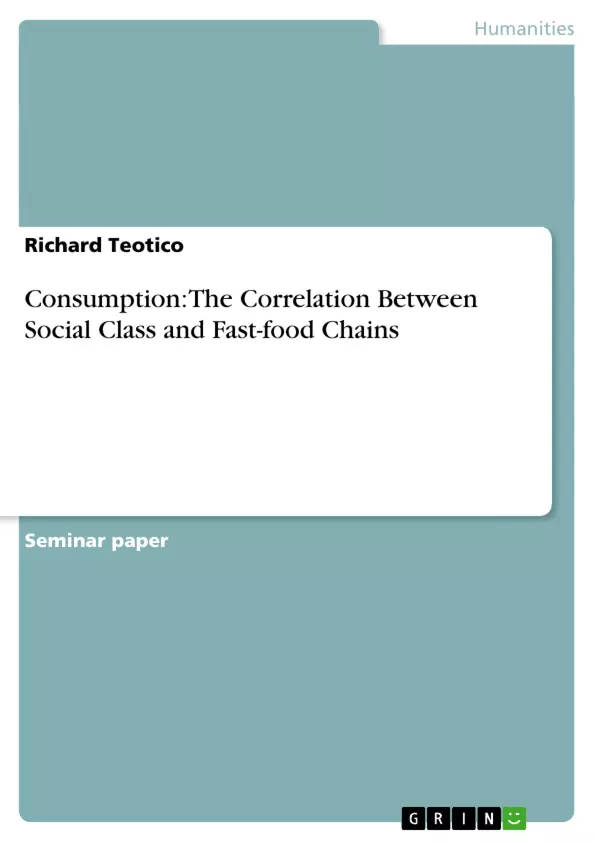((First year Sociology course, APA))
...Specifically, this paper will focus on three key ideas. First, it will focus on the premise of media portrayal of class images. What are the implications of media images defining social norms? Who controls the media? Second, what impact do fast-food chains have on the remuneration of their employees and other job sectors? Fast-food chains are competing with one another, but how do they focus on the bottom line? Third, what are the ramifications of uniformity and are they already taking place?
Inhaltsverzeichnis (Table of Contents)
- Introduction
- Media portrayal
- Remuneration
- Uniformity
Zielsetzung und Themenschwerpunkte (Objectives and Key Themes)
This paper explores the relationship between social class and fast-food chains in North America, drawing on the work of Porter and Schlosser. It examines how media portrayals of class influence consumer behavior, analyzes the impact of fast-food chains on employee remuneration, and investigates the consequences of a growing uniformity in consumer preferences.- The influence of media images on class perceptions and social norms
- The impact of fast-food chains on employee wages and working conditions
- The consequences of uniformity in consumption patterns, particularly in relation to fast-food chains
- The role of corporations in shaping social attitudes and practices
- The relationship between class and consumption
Zusammenfassung der Kapitel (Chapter Summaries)
- Introduction: The paper introduces the central themes of social class and fast-food chains, drawing on the works of Porter and Schlosser. It outlines the key concepts and questions that will be explored throughout the paper.
- Media portrayal: This section examines the role of media images in shaping perceptions of social class. It argues that advertisements often depict a glamorous and unattainable lifestyle, creating a desire for consumption that can lead to social change. The paper also explores the lack of representation of lower-class experiences in media portrayals.
- Remuneration: This section examines the impact of fast-food chains on employee remuneration. The paper discusses the declining minimum wage and the use of exploitative practices by fast-food corporations, such as discouraging unionization and hiring undocumented workers. It also highlights the high turnover rates in the fast-food industry.
- Uniformity: This section explores the consequences of a growing uniformity in consumer preferences. It discusses the rise of franchises and the increasing dominance of generic brands in the fast-food industry. The paper argues that this trend leads to a decline in product diversity and potentially limits worker opportunities in the future.
Schlüsselwörter (Keywords)
This paper examines the relationship between social class and fast-food chains in North America. Key concepts include media portrayals, class consciousness, consumption, employee remuneration, working conditions, and the impact of corporate practices on society. The paper draws upon sociological theories of class and power, as well as case studies from the fast-food industry.
Final del extracto de 9 páginas
- subir
- Citar trabajo
- Bachelor of Arts Criminology and Psychology Richard Teotico (Autor), 2007, Consumption: The Correlation Between Social Class and Fast-food Chains, Múnich, GRIN Verlag, https://www.grin.com/document/210787
Leer eBook



